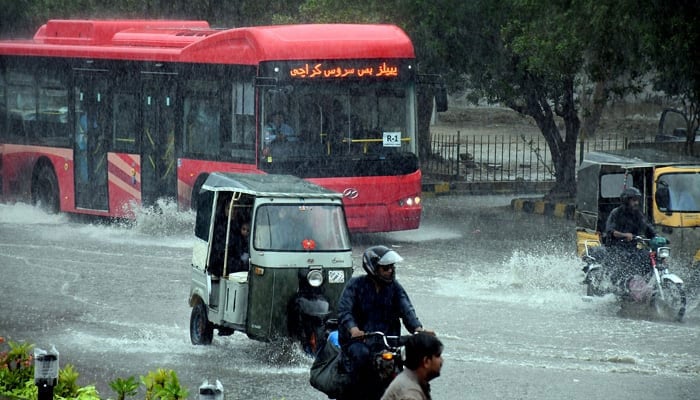Can our cities survive the climate crisis?
From floods to relentless heatwaves and severe droughts, our nation stands at front lines of climate change
“Only when the last tree has been cut down, the last fish been caught, and the last stream poisoned, will we realize we cannot eat money.” This prophetic warning resonates deeply as we reflect on the environmental catastrophes that plague Pakistan.
From devastating floods to relentless heatwaves and severe droughts, our nation stands at the front lines of climate change, grappling with its harsh realities.
The recently concluded World Environment Day (June 5), themed ‘Generation Restoration’, reminds us that it is imperative to confront these challenges and rethink our approach to urban development and environmental stewardship.
Pakistan’s cities are expanding at an unprecedented rate. According to the 2023 Population and Housing Census, urbanization in Pakistan has surged to 38.8 per cent, with the urban population growing at an annual rate of 3.57 per cent between 2017 and 2023. This rapid urban expansion, often unplanned and poorly managed, has significantly increased the vulnerability of urban areas to climate-related disasters.
The transition from riverine to urban flooding, as witnessed in the catastrophic floods of 2022 that affected 33 million people and submerged a third of the country, is a clear indicator of the dire consequences of mismanaged urban growth. This unbridled growth often comes at the expense of natural floodplains and green spaces, leaving urban areas more susceptible to floods, droughts and heatwaves.
The real-estate sector also plays a pivotal role in this crisis. Globally, the industry accounts for around 40 per cent of total global emissions, a staggering figure that underscores its environmental impact. In Pakistan, unchecked development driven by profit motives has led to the proliferation of grey infrastructure – buildings and roads that replace natural landscapes, increase surface runoff, and exacerbate urban heat islands.
The lack of green spaces in cities intensifies heat stress, making urban areas almost unbearable during heatwaves. For instance, the summer of 2023 saw temperatures in many Pakistani cities soar above 45 degrees Celsius, posing severe health risks to the population. Now again in 2024, Pakistan faces prolonged heatwaves with temperatures soaring to 50 degrees Celsius in many parts of the country.
According to flood forecasting models and satellite data, it has been predicted that the country might face extreme flooding again. Once primarily subjected to riverine flooding, Pakistan now contends with more frequent urban floods, a shift worsened by unplanned urbanization and environmental negligence.
This trend was starkly evident in Swat during the floods of 2022, as the river reverted to its natural course, submerging hotels and roads entirely. Similarly, Karachi experienced severe urban flooding, even in affluent neighbourhoods, where water stagnated for hours and, in some areas, days.
Encroachments on natural landscapes further compound these issues. The twin cities of Islamabad and Rawalpindi illustrate this problem starkly. Natural water streams such as Soan, Korang, and Leh rivers have been severely encroached upon. Housing developments and industrial activities along these waterways have drastically degraded water quality and disrupted natural flows.
To cater to the needs of urbanization, housing societies are being constructed by altering the routes of these natural water streams. That is why every year, these spaces along these natural water streams face severe floods and people die as well.
Additionally, the escalation of urbanization and industrial development near water tributaries has led to river degradation. Private housing societies have been known to dump waste directly into these rivers, deliberately polluting them and exacerbating the problem. River Soan, among others, is heavily polluted due to municipal sewage discharge and industrial waste. This pollution not only threatens aquatic life but also poses health risks to communities relying on these water sources. Moreover, the alteration of natural water courses in urban planning disrupts ecosystems and increases the risk of flooding.
Due to floodplain encroachments in the twin cities, soil subsidence and erosion can also pose a challenge. The construction along floodplains increases the chances of soil liquefaction – a phenomenon where saturated soil loses its strength and behaves like a liquid during stress events such as floods or earthquakes. This was tragically illustrated in Joshimath in India, where buildings developed cracks due to shifting soil.
In Pakistan, similar risks are evident, especially along riverbanks where construction stresses the soil, leading to potential subsidence and infrastructure damage. The issue of extreme moisture in some of the housing societies constructed along River Soan has been of great concern for the residents because of altering the natural boundaries of the river.
According to the Global Climate Risk Index, Pakistan ranks among the top 10 countries most affected by extreme weather events, highlighting the urgent need for climate resilience. The challenges of urban heat stress are exacerbated by shrinking green spaces. Cities transform into heat islands, with concrete structures absorbing and radiating heat, exacerbating the effects of rising temperatures. This lack of green cover and poor urban planning leaves many urban residents exposed to extreme heat, which often gets prolonged, and dry conditions severely damage the crops and shrink water resources.
Generational priorities have also played a significant role in shaping the current landscape. Baby Boomers and Generation X prioritized rapid infrastructure development, often at the expense of environmental sustainability.
Today, Millennials and Generation Z are grappling with the fallout – rising temperatures, disappearing natural landscapes, and an increased frequency of climate disasters. Yet, these younger generations are also the torchbearers of change, advocating for sustainable practices and demanding that policymakers and developers prioritize the environment over short-term gains.
The path forward demands urgent and concerted action. Strengthening urban planning and infrastructure is paramount. Most cities in Pakistan lack comprehensive master plans, and urban climate resilience is not integrated into existing urban policies and planning frameworks. Municipalities must enhance their capacity for sustainable development, ensuring that new projects adhere to environmental regulations and building codes.
The real-estate sector needs stringent oversight, with developers held accountable for their environmental impact. Restoring natural ecosystems – removing illegal encroachments and rehabilitating degraded areas – is crucial to rebuilding our cities’ resilience.
Local governments need to be established and their capacities strengthened so they can effectively manage climate shocks. Engaging communities in the planning and implementation processes is vital; a combination of top-down and bottom-up approaches is necessary to address these challenges comprehensively. This collaborative effort will ensure that cities are not only prepared for future climate extremes but are also able to thrive in harmony with their natural environments.
There is also a need to integrate climate risk insurance policies to enhance urban climate resilience in Pakistan. This insurance can incentivize investments in resilient infrastructure and sustainable urban development practices. Developers and policymakers, knowing they have insurance coverage for climate-related damages, may be more inclined to prioritize climate-smart housing and infrastructure projects.
Furthermore, by leveraging data from the financial and real-estate sectors, tailored insurance products can accurately assess and mitigate climate risks, making more informed urban planning decisions. Climate risk insurance also acts as a vital safety net for vulnerable communities, offering financial assistance for recovery efforts in the aftermath of climate-related disasters.
There is a lot of potential under the UN Living Indus Initiative, an umbrella initiative by the UN, the government of Pakistan, and the Ministry of Climate Change and Environmental Coordination. The initiative aims to lead and consolidate actions to restore the ecological health of the Indus within the boundaries of Pakistan, which is most vulnerable to climate change and has been sustaining many civilizations for many centuries.
However, since the ecosystem is degrading along the Indus, the question is: will it be able to sustain itself for the next century? Therefore, the top intervention prioritized under the Living Indus initiative is ‘green infrastructure for flood control and groundwater recharge’. This intervention can help support urban climate resilience in many cities along the bank of the Indus where riverine floods exacerbate urban flooding.
Environmental education and advocacy are equally important. Younger generations must be empowered to lead the charge for sustainability, their voices amplified in policymaking processes. As they push for change, they embody the spirit of ‘Generation Restoration’, a movement dedicated to healing our planet and securing a sustainable future.
This World Environment Day should make us heed the lessons of the past and commit to a future where urban resilience and environmental sustainability are not just goals but imperatives.
The challenges are immense, but with collective resolve and a steadfast commitment to restoration, we can build cities that not only withstand the forces of nature but thrive in harmony with it.
The writer heads the programme onecological sustainability and circular economy at the Sustainable Development Policy Institute (SDPI).
-
 Dave Filoni, Who Oversaw Pedro Pascal's 'The Mandalorian' Named President Of 'Star Wars' Studio Lucasfilm
Dave Filoni, Who Oversaw Pedro Pascal's 'The Mandalorian' Named President Of 'Star Wars' Studio Lucasfilm -
 Is Sean Penn Dating A Guy?
Is Sean Penn Dating A Guy? -
 Sebastian Stan's Godmother Gives Him New Title
Sebastian Stan's Godmother Gives Him New Title -
 Alison Arngrim Reflects On 'Little House On The Prairie' Audition For THIS Reason
Alison Arngrim Reflects On 'Little House On The Prairie' Audition For THIS Reason -
 Spencer Pratt Reflects On Rare Bond With Meryl Streep's Daughter
Spencer Pratt Reflects On Rare Bond With Meryl Streep's Daughter -
 'Stranger Things' Star Gaten Matarazzo Recalls Uncomfortable Situation
'Stranger Things' Star Gaten Matarazzo Recalls Uncomfortable Situation -
 Gaten Matarazzo On Unbreakable Bonds Of 'Stranger Things'
Gaten Matarazzo On Unbreakable Bonds Of 'Stranger Things' -
 Beyonce, Jay-Z's Daughter Blue Ivy Carter's Massive Fortune Taking Shape At 14?
Beyonce, Jay-Z's Daughter Blue Ivy Carter's Massive Fortune Taking Shape At 14? -
 Meghan Markle Fulfills Fan Wish As She Joins Viral 2106 Trend
Meghan Markle Fulfills Fan Wish As She Joins Viral 2106 Trend -
 Selena Gomez Proves Point With New Makeup-free Selfie On Social Media
Selena Gomez Proves Point With New Makeup-free Selfie On Social Media -
 John Mellencamp Shares Heartbreaking Side Effect Of Teddi's Cancer
John Mellencamp Shares Heartbreaking Side Effect Of Teddi's Cancer -
 Kate Middleton 'overjoyed' Over THIS News About Meghan Markle, Prince Harry
Kate Middleton 'overjoyed' Over THIS News About Meghan Markle, Prince Harry -
 'Harry Potter' Star Brendan Gleeson Reluctantly Addresses JK Rowling's Trans Views
'Harry Potter' Star Brendan Gleeson Reluctantly Addresses JK Rowling's Trans Views -
 Priscilla Presley Reveals The Path Elvis Would Have Taken If He Were Still Alive
Priscilla Presley Reveals The Path Elvis Would Have Taken If He Were Still Alive -
 Kianna Underwood's Death Marks Fourth Nickelodeon-related Loss In Weeks, 9th Since 2018
Kianna Underwood's Death Marks Fourth Nickelodeon-related Loss In Weeks, 9th Since 2018 -
 Hayden Christensen Makes Most Funny 'Star Wars' Confession Yet
Hayden Christensen Makes Most Funny 'Star Wars' Confession Yet




